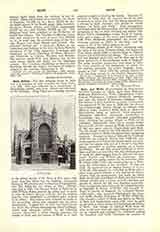

Bath and Wells (BADONIENSIS ET WELLENSIS) Ancient Diocese of (Bath, Aquae Solis, Bathonia, Bathensis, Bathoniensis; Wells, Theoradunum, Velliae, Ecclesia Fontanensis, Vellensis, Wellensis), coextensive with the County of Somerset, England. The first Bishop of Bath and Wells, properly so described, was appointed by the pope in 1244, but the diocese has a much longer history, though its bishops used different titles; Somerset, Wells, Bath, or Bath and Glastonbury, being at different times employed. Aethelhelm (909-914), afterwards Archbishop of Canterbury, first exercised episcopal jurisdiction there, choosing the secular church of Wells as his cathedral. Henceforth, there was a certain rivalry between the secular canons of Wells and the monks of the two great abbeys, Glastonbury and Bath. The advantage, however, lay with the latter and the cathedral church at Wells maintained but a struggling existence. During the time of Edward the Confessor (1042-66), the energetic Bishop Gisa (1060-88), who on his appointment found the church small and poor, and the few canons who served it forced to beg their bread, succeeded in putting matters on a firmer foundation. He not only erected buildings in which they could live a community life, but obtained grants of lands for their support from St. Edward the Confessor, Harold, and William the Conqueror. This good work was partly undone by his successor, John de Villula (1088-1122), who removed the see to Bath using the abbey there as his cathedral. It was not until the appointment of Bishop Robert of Lewes (1136-66), who rebuilt the cathedral at Wells and in other ways proved himself a wise and liberal administrator, that an arrangement was made by which Bath should take precedence of Wells, but that future bishops should have a throne in both churches and should be elected by the two chapters conjointly. This arrangement lasted through the administrations of Reginald de Bohun (1174-91), who brought St. Hugh of Lincoln to England; the turbulent Savaric (1192-1205), who annexed Glastonbury by force, and lastly Jocelin Troteman de Welles (1206-42), who though a native of Wells was known as Bishop of Bath and Glastonbury until 1219, when he gave up all claim to Glastonbury and styled himself Bishop of Bath. But though he omitted Wells from his title, he did more than any other bishop for the town, for he restored and enlarged the cathedral, adding the beautiful west front, increased the number of canons from thirty-five to fifty, and founded a grammar school. On his death, the monks of Bath ignoring the chapter of Wells, elected as his successor Roger, one of their own community, for whom they obtained royal and papal confirmation, but the consequent appeal by the Wells chapter brought about the final settlement of the difficulty. The pope decided that Roger should remain bishop with the style “Bishop of Bath and Wells”, and that the old arrangement as to joint election should in future be observed.
The history of the see was thenceforth tranquil, only three bishops during the next two centuries calling for special mention, Ralph of Shrewsbury (1329-63), who completed the buildings; Thomas Bekynton (1443-65), another liberal benefactor of the city; and Oliver King (1495-1503), who rebuilt Bath Abbey in the Perpendicular style. One bishop, William Bytton (1267-74), died with a reputation for sanctity and his tomb became a place of pilgrimage. In the fifteenth century there were two absentee bishops, Adrian de Castello (1504-18), during whose tenure the see was administered by the historian Polydore Vergil; and Cardinal Wolsey (1518-23), who held the see simultaneously with that of York. After the dissolution of Bath Abbey in 1538, the bishop, though retaining the old style, had his seat at Wells alone, but final ruin was impending. In 1549 the notorious William Barlow was intruded into the see, and alienated much of its property. On the accession of Mary he fled, and was succeeded by the last Catholic Bishop, Gilbert Bourne (1554-59), who held the see till he was deprived of it by Elizabeth and imprisoned in the Tower, thus becoming one of the eleven Confessor-Bishops who died in bonds. He died in 1569. Of the twin cathedrals of the diocese, Bath Abbey was rebuilt (1499-1539) in late Perpendicular style and is the last complete monastic building erected before the Reformation, while the cathedral at Wells, though small, is the most perfect example of a secular cathedral and one of the most beautiful Gothic buildings in England. Dating in the main from the early thirteenth, it was practically complete by the middle of the fourteenth century. The diocese contained three archdeaconries, Bath, Wells, and Taunton. The arms of the see were: Azure, a saltier quarterly quartered, or and az.
EDWARD BURTON

